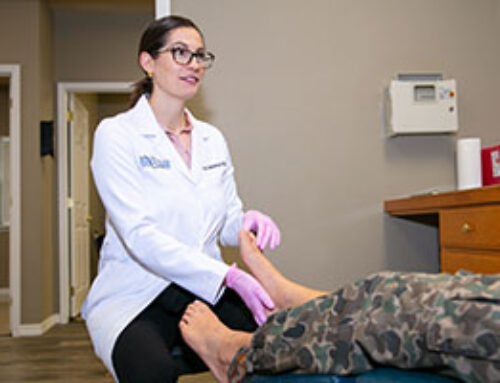Toenail fungus isn’t just the subject of those creepy commercials – it’s a real problem. If it goes unaddressed, it can cause not only pain and embarrassment but lead to a host of health problems.
How toenails get infected
Fungal infections in the toenail are formally called onychomycosis. Several different types of fungi can cause these infections, but the most common ones are called dermatophytes. These fungi are all around us, looking for warm and wet environments. Toenails are more susceptible to fungus than fingernails partly because they are frequently in enclosed spaces where it is harder for cooling and drying to occur. Lower blood circulation is also a factor.
These fungi are extremely contagious and can easily be spread through contact with an infected person or surface. They feed off keratin, the tough substance our nails are made of. If they reach the feet, they will eat their way through the nail to the skin below and take root, causing all sorts of nasty problems.
Symptoms of toenail fungus
An infected toenail may turn an unnatural-looking color, such as pale white, yellow, or brown.
A foul smell may emanate from the toe. You may notice that the nail’s shape has become warped or distorted. The nail will usually become brittle and start cracking easily. It may also become unusually thick.
Risk factors for toenail fungus
Certain conditions increase the chance of developing toenail fungus. Roughly 30% of diabetics are affected by toenail fungus, compared to just 8% of the general population. Diabetes causes nerve damage, leading to loss of sensation; as a result, you may not be able to feel pain that would normally tip you off to problems like toenail infections. Diabetes can cause circulation problems, a recipe for trouble given that the toes already have relatively limited blood flow. Diabetes can also weaken the immune system, limiting the body’s ability to fight infections.
Those with hyperactive sweat glands (a condition known as hyperhidrosis) are at a higher risk because the excess sweat makes it harder to keep the feet dry. About one third of people with psoriasis will develop a fungal infection. Note that psoriasis shows many similar symptoms to fungus, so compare the two to be sure which you have. Older people are more susceptible due to a combination of reduced blood flow and more exposure to fungi over their longer lives. Those with a family history of toenail fungus are also more likely to be affected.
Complications of toenail fungus
The presence of the fungi under the toenail can cause the nail to separate from the nail bed. If this happens, the nail may have to be removed, and it may take up to 18 months to grow back properly.
Nail lifts off the nail bed. The presence of the fungi will lift the nail off the nail bed,
And won’t reattach in further growth. Reversing this is very hard.
The fungus can spread further throughout the body. When it affects the skin on the foot between the toes, it is called athlete’s foot. If it reaches the groin, it causes jock itch. These conditions can cause itching, blistering, inflammation, peeling of the skin, and a stinging sensation.
Treating toenail fungus
No physical therapy options are available to treat toenail fungus. Properly fighting it will require doctor-prescribed medication. The most common of these are topical treatments available under brand names like Jublia, Kerydin, and Penlac. These creams must be applied daily. They can be effective for early or superficial infections that only affect the surface of the nail. However, if the fungus has gotten beneath the nail, it could take as long as a year to see substantial improvement. The process may be helped by filing down the nail to reduce its thickness, making it easier for the solutions to get to the source of infection. About 35% of patients who use these treatments report being cured of their symptoms. There are also topical treatments available over-the-counter that purport to help with the cosmetic effects of fungal infections, but most doctors agree that these have no effect.
Also available but less common are oral medications available under brand names like Sporanox and Lamisil. These drugs have higher cure rates than topical creams, but also have a multitude of unique risks. They can be harmful when mixed alcohol, and they may also interact poorly with other medications. They make the skin more sensitive to sunlight. They may also harm the liver or kidneys, which is common enough that many patients have to be tested for damage every 4 to 6 weeks.
Preventing toenail fungus
Given the difficulty of eliminating toenail fungus, the best offense in dealing with it is a good defense. There are several steps you can take to prevent infections from taking root.
- Keep your feet clean and wash them regularly, as the fungi that cause infections are highly contagious. On that note, wash your hands as well.
- Keep your feet dry. When you are in wet public areas, such as pools or shower rooms, wear flip flops to minimize your foot’s contact with the water, as someone else’s infection could be in there looking for a new home.
- Trim your toenails regularly and properly. The toenails should be kept short, because this provides less space for fungi to get in. They should be cut straight, as jagged shapes make it more likely for them to be broken, which makes them more vulnerable to infection. Proper toenail grooming also helps to fight ingrown toenails. Disinfect your clippers, files, and other tools used for toenail care. If you visit a salon, ensure they are doing the same.
- Wear shoes that aren’t too tight, as fungi love cramped environments. Keep your shoes off at home to let your feet breathe, and consider wearing open-toed shoes in warm weather. Try alternating pairs of shoes on different days to allow each one to completely air out. Replace your shoes frequently and don’t share them with anyone else.
- Keep your socks dry, and choose socks that absorb moisture.
- Apply antifungal powders to your shoes and socks to prevent fungi from growing.
Most importantly, if you start noticing symptoms, act right away! Symptoms tend to come on gradually. This may give you a chance to act if you catch mild symptoms early. However, it can also result in the problem going undetected for too long. Don’t risk it – contact a podiatrist to get the care you need. Here at Metro Tulsa Foot & Ankle Specialists, we know that toenail fungus can be embarrassing and painful.
We know that fighting it can be a slow, frustrating process. That’s why we will provide the best care we can every step of the process in your battle. Schedule an appointment today at any of our 5 Greater Tulsa locations.
Subscribe to stay up-to-date on news and tips from us.





